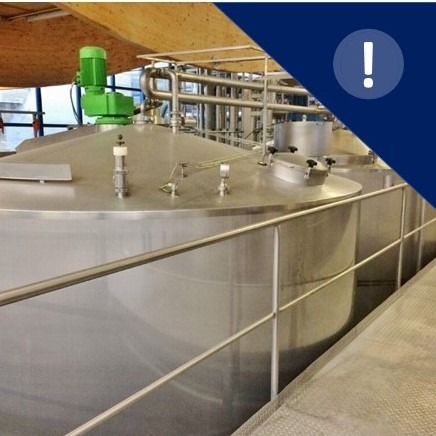
6 common mistakes to avoid when operating a stainless steel tank
1. Pay attention to select the appropriate type of stainless steel
Investigate prior to purchase if your medium requires a specific stainless steel grade. The most common stainless steel grade is AISI304. However, there is a large number of higher grade alloys which is often classified within the term AISI316. If your medium contains salt, chlorides, or acid to a certain extent, then AISI316 might be the better choice. Having said that, even unsuspicious fluids such as spring water can surpass some critical thresholds which might reflect a potential risk. Hence a water analysis is always advisable.
2. Insufficiently dimensioned ventilation valves
The diameter of the ventilation valve installed on the tank must at least correspond to the outlet size of the tank so that no vacuum or overpressure can arise in the tank. This ensures that the flow rate of the ventilation valve also corresponds to the tank filling rate. If the ventilation capacity is less than the speed at which your medium is emptied, the tank can implode. This can also happen if the ventilation valve is blocked or defective. The ventilation must therefore be carefully examined in a regular manner.
3. Train employees how to safely operate the tanks
Even if operating a stainless steel tank or reactor seems intuitive and easy, accidents occur again and again when untrained staff replace their colleagues during vacation or in the event of illness. You should therefore create operating and maintenance instructions that are visibly attached to the tank. This ensures that even inexperienced employees know exactly which steps must be carried out in which order.
4. CIP cleaning: Let the tank cool down before filling it with hot product
If cold media enter the tank immediately after hot media, the tank can implode. This is due to the fact that the tank did not have sufficient time to cool down and / or an adequately sized vent valve was not installed on the tank. Sufficient ventilation of the tank is essential to ensure that sufficient air can enter the tank, thereby compensating for the volume that has changed during steam condensation.
5. Agitators must not run dry
Agitators with mechanical seals must not run dry, but must be lubricated with the medium contained inside the tank. This is particularly relevant for agitated tanks with a side-mounted agitator in the cylindrical part of the tank. Therefore, pay attention to the filling level of your medium in the tank, when operating the agitator.
6. Clarify your documentation requirements prior to procurement
Before purchasing a stainless steel tank, consult with all parties involved to determine whether there are certain requirements for the technical documentation. In the case of large storage tanks for outdoor installation, for example, there could the need for a statical report. In case of a pressure vessel, your local pressure equipment directive authority might require a set of authorizing papers. Contact your Behälter KG representative to clarify related questions. Even if no documentation is on file, we can offer a stainless steel grade report for all tanks, due to our X-ray spectrometer.
Example: tank-implosion, resulting from an insufficient tank ventilaton
